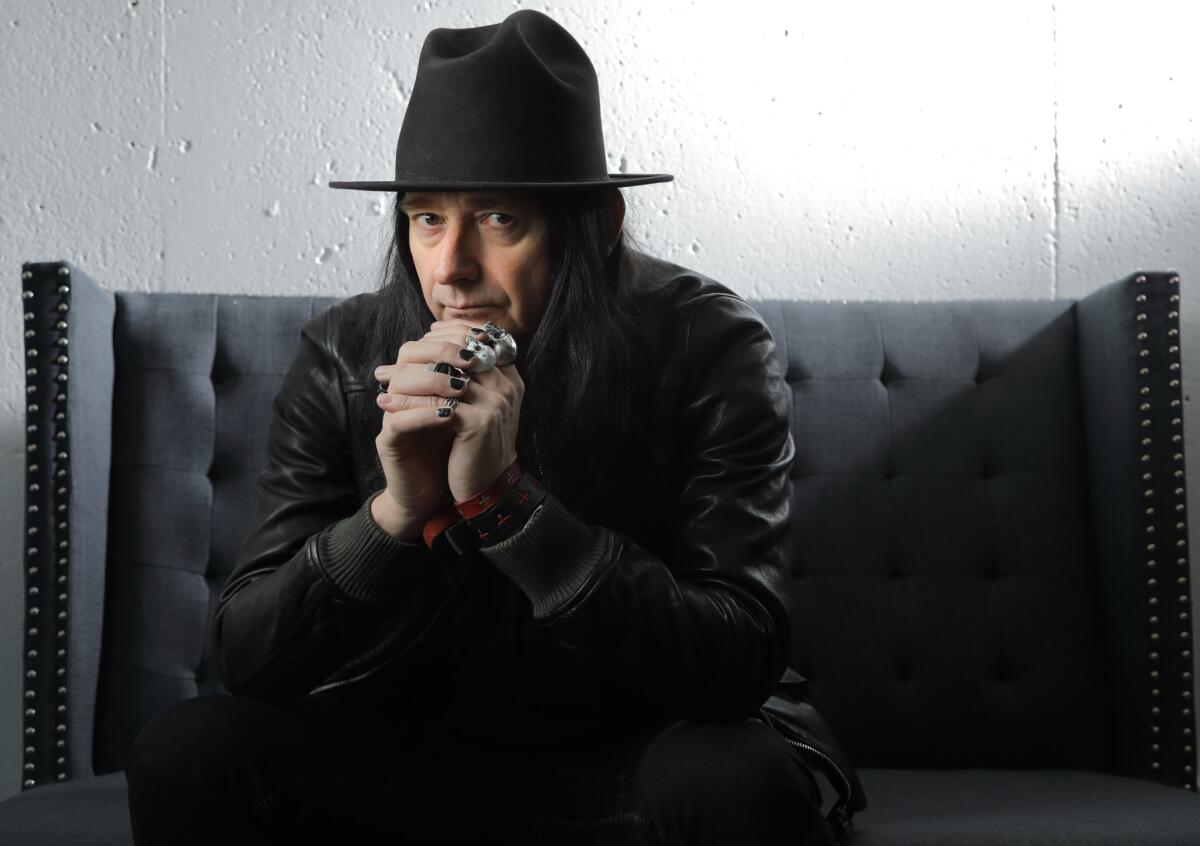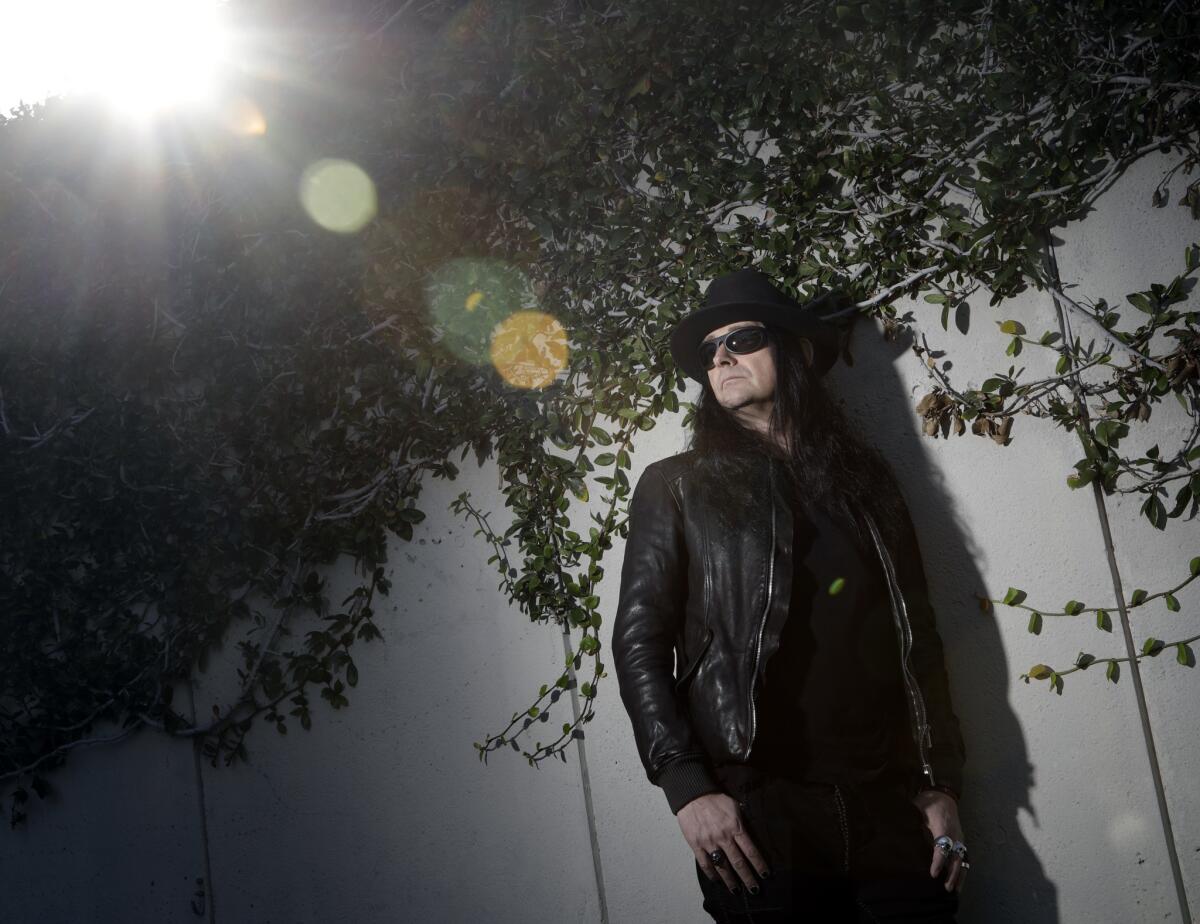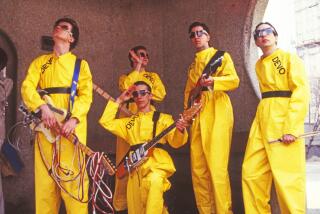Satanic worship, church burnings and murder: The true story behind ‘Lords of Chaos’

- Share via
The terrible dawn of Norwegian black metal came during the summer of 1984, during an adolescent season of inspiration in a small village outside Oslo.
Guitarist Oystein Aarseth and bassist Jorn Stubberud, both 16, formed a band called Mayhem, fueled on their love for the bleakest forms of heavy metal, slasher films and an attraction to rebellion and evil. To signify their break from mainstream Christian society — and in opposition to the glam-metal dudes in hairspray and spandex — the Mayhem founders took on ominous new identities: Aarseth would be known as “Euronymous,” Stubberud as “Necrobutcher.”
“That’s why we started to wear our hair all black. We were singing about Satan and sadism, and everything that was wrong like torture and stuff like that — the opposite of hanging around at the beach,” Necrobutcher, now 50, recalled of those days. “We were looking for perversity and craziness.”
They found it in their creation of a frantic metal subgenre that was uniquely grim and threatening, just as Mayhem and others in the Norwegian black metal scene began to stumble from a frightening made-up image and into tragic reality. Within a decade, bandleader Euronymous was murdered by another band member, and a Mayhem singer was dead from suicide. Others were sent to prison for murder and dozens of churches across the country had been burned to the ground by band members and black metallers inspired by their example.
It remains one the most notorious and disturbing stories from the rock ‘n’ roll underground, the subject of multiple books and documentaries. Now a stark new feature film, “Lords of Chaos,” has taken on this real-life cautionary tale of youthful excitement and genuine horror.
The film, which comes out Thursday, was directed by Swedish filmmaker Jonas Akerlund, who’s uniquely suited to tell this story with real empathy and dark humor. Before he was an award-winning director of features, commercials and music videos for Madonna, U2 and Lady Gaga, Akerlund was the founding drummer for Bathory, a Swedish metal act that was a key influence on Norwegian black metal.
He knew musicians from that scene and was mutual friends with many more. In “Lords of Chaos,” the result is that these young Scandinavians are not the tabloid villains they became in the ‘90s but are depicted more in the tradition of Larry Clark’s “Kids” or “Bully,” or Tim Hunter’s grim 1986 teen drama “River’s Edge” — unromanticized stories of young adults dangerously close to self-destruction.
Winter movie preview: ‘Captain Marvel,’ ‘Dumbo’ and nearly 200 more new releases »
When the director met with surviving families and wary band members in preparation for the film, he told them, “This is the first document of these young boys that humanizes them and shows they were young and they were kids like any of our kids — and it went wrong, obviously.”
For actor Rory Culkin, who plays the doomed impresario Euronymous, the lines between fantasy and reality were comically, horrifically blurred.
“These kids were killing people and burning churches, but then they were also doing photo shoots in cemeteries, trying to look scary,” said Culkin, 29. “Euronymous was playing a part and playing the game, and then people took to it and thought he was for real.”
Ahead of the tragic events to come, a party scene early in “Lords of Chaos” finds a delirious crowd in denim and black leather at the Mayhem house, blasting Dio’s “Stand Up and Shout” on the stereo to a frenzy of headbanging, fire-breathing, random sex and projectile vomiting.
“The first act of the film, before it becomes too serious, is very much how I grew up,” recalled Akerlund, who co-wrote the screenplay. “We had those garden parties, and we were trying to find our sound, trying to find our look, awkward with girls and awkward with everything.”
Now 53, Akerlund still looks the part in black clothes and long black hair on a recent visit to Los Angeles, where he keeps a home. His fingernails are painted black, and he wears a prominent skull ring on his right hand.
“Lords of Chaos” is based on a 1997 book of the same name, plus Akerlund’s firsthand knowledge of that first black metal generation and subsequent research: watching and reading old interviews, studying photos and police reports.
At the center of the story is Euronymous. The young guitarist led Mayhem and ran a record shop in Oslo called Helvete (translation: “Hell”) and owned the record label Deathlike Silence Productions. His immediate crowd of friends and collaborators was known loosely as “the black circle.”
He was a shameless promoter of the band and exaggerator of evil intent. In one “Lords of Chaos” scene, Euronymous informs a young female photographer (Sky Ferreira): “We don’t want any ... groupies. We’re into destruction and suffering. When people hear our music, we want them to commit suicide.”
The band’s trajectory took a dark turn after the arrival of Per Yngve Ohlin (a.k.a. “Pelle”), a gifted metal singer and lyricist from Sweden obsessed with death, particularly his own. He renamed himself Dead and brought a startling level of brutal theatricality to the band, slicing his arm with a knife to drip blood on the front rows and tossing severed pigs heads into the crowd.
“The lyrics that he wrote for us were so deep and so personal and so heartbreaking and everything at the same time,” Necrobutcher recalled of Dead. “Beautiful, dark, great, all the emotions are in there. He was a true genius, that guy.”
Mayhem was preparing to record its first studio album when Dead, 22, killed himself with a knife and shotgun in 1991. Euronymous found his body, but before alerting police, he took several grotesque snapshots of the death scene. He planned to use the photos to add further mystique to the Mayhem name.
2019 Oscar roundtables: Watch every single video interview »
“My friend kills himself, and then my best friend finds the body, and instead of having a reaction of sorrow and grief, he reacted differently and took photos of the body,” Necrobutcher said. “I was like, ‘You have to get rid of those photos or I will never see you again.’ ” He expected his friend and co-founder to come to his senses. Necrobutcher ended up quitting the band.
In his place came Kristian “Varg” Vikernes, a.k.a. Count Grishnackh, whose black metal project Burzum was signed to Euronymous’ label. He became Mayhem’s bass player, and as portrayed in the film (by Emory Cohen), Vikernes is a true believer in the band’s slogans of evil intent.
Vikernes initiates a campaign of church arsons in Norway, allegedly starting with the 12th century Fantoft stave church outside Bergen, a spectacular wooden structure with Norse dragon-head carvings. After it was torched in 1992, Vikernes photographed the remains for his next Burzum album cover. Soon after, Vikernes told a journalist from the Bergens Tidende daily newspaper, “Our purpose is to spread fear and evil.”
By then, Akerlund was living in the U.K., pursuing a film career, when he saw a CNN report on the church burnings.
“We all knew what was going on,” the director said, adding that Bathory’s influential late frontman, Quorthon, “didn’t like the Norwegian scene because they couldn’t separate reality from fantasy.”
Police also took notice. In 1993, Necrobutcher and Euronymous were talking again and planning on an upcoming tour to celebrate 10 years of Mayhem. Weeks later, Euronymous was killed in his Oslo apartment, stabbed 23 times by Vikernes, who claimed self-defense. He was convicted of murder at age 20.
“That is an old traditional fight, slandering and death threats start to fly between two people, and in the end one of them says, ‘You know what, I’m going to ... kill you,’ ” explained Necrobutcher, seeking to demystify the crime. “That’s very traditional and mixed with power, money.”
In the 1990s, Michael Moynihan was a Denver-based music journalist already drawn to “weird violent aspects of heavy metal,” when U.K. metal magazine Kerrang! published a cover story on the Norwegian black metal scene. On the cover was Vikernes, a blade in each hand, black hair over his face, and a headline that promised: “Arson ... Death ... Satanic Ritual: The Ugly Truth About Black Metal.” Moynihan wrote to a friend in Norway, writer Didrik Soderlind: “Is this stuff true?”
Soon they were collaborating on the book “Lords of Chaos,” published that decade by Feral House. By then, Euronymous was dead and Vikernes in prison. Moynihan spent two weeks in the country to interview musicians, family members, police investigators and other locals.
“Oystein had the belief, the more extreme the better, the more unbelievable the better,” Moynihan said of Euronymous. “Then you have someone like Vikernes who comes in and starts taking it at face value, saying, ‘We can’t just talk about this stuff. We’ve got to do it.’ It was the combination of the two of them meeting that pushed things over the edge.”
“The people I met over there, they really are artists,” Moynihan added. “They were very naive in lots of respects, and they were kids, and they did some real stupid stuff — which I think most of them probably regret. On the other hand, they were also talented creative people.”
Principal photography on the film “Lords of Chaos” was done during a tight 18-day shoot in 2017, mostly in Budapest but with one day set aside for Oslo. While there, the production was trailed by photographers from the local tabloid press, reflecting an intense ongoing national interest in the Mayhem story.
“People think they own it, and people think they are closer to this story than anybody else,” Akerlund said.

REVIEW: ‘Lords of Chaos’ skims the surface of bloody killings, Satanic rituals and black metal »
“Everybody has their own perspective, and everybody has a friend or a brother or ‘I was there’ kind of story. Then I realized that I’m one of those and that also think I own this story,” he said, with a laugh. “Not many bands get a movie. You have to be Queen to get a movie or the Doors. But Mayhem got a movie.”
Necrobutcher has seen the film at least twice but won’t comment until after it’s been released, he said, so audiences “can make up their own minds if they like it or it’s horrible, if they’re crying or laughing.”
But it’s notable that Mayhem allowed its music to be used. And current singer Attila Csihar, whose work with Mayhem dates back to the 1994 album debut, “De Mysteriis Dom Sathanas,” visited the set in Hungary during a church arson scene and invited Culkin to his home. Vikernes, who continued to record albums as Burzum while in prison, was released in 2009 ahead of his maximum 25-year sentence.
Now living in France with his wife and two children, he frequently posts his video musings online and has already given the film a negative review, without actually seeing it.
Necrobutcher prefers to forget the nightmarish events of Mayhem’s first years yet in 2016 was persuaded to collect his old photographs and recount that history for a book, “The Death Archives: Mayhem 1984-94.” He was urged by his co-author, Svein Strommen, not only to share the material with fans, but to tell the story of that era from the perspective of someone who lived it.
The bass player is now working on a second book, this one looking at the band’s second decade, as Mayhem resurrected itself and tried to put the bad memories behind. On his cellphone in Norway, Necrobutcher said he was en route to a band rehearsal in preparation for a new album and tour. Some things are off limits, including that gruesome photo of Dead’s body.
“I might punch you in the face if you wear that on a T-shirt,” he warned. He also has a 7-year-old grandson, Jorn Stubberud Jr., who says he wants to play music too. “He says to me, ‘Grandad, I want to be like you,’ ” said Necrobutcher, sounding amused. “Even now, I’m thinking about the new generations. It’s still ongoing.”
More to Read
Only good movies
Get the Indie Focus newsletter, Mark Olsen's weekly guide to the world of cinema.
You may occasionally receive promotional content from the Los Angeles Times.











